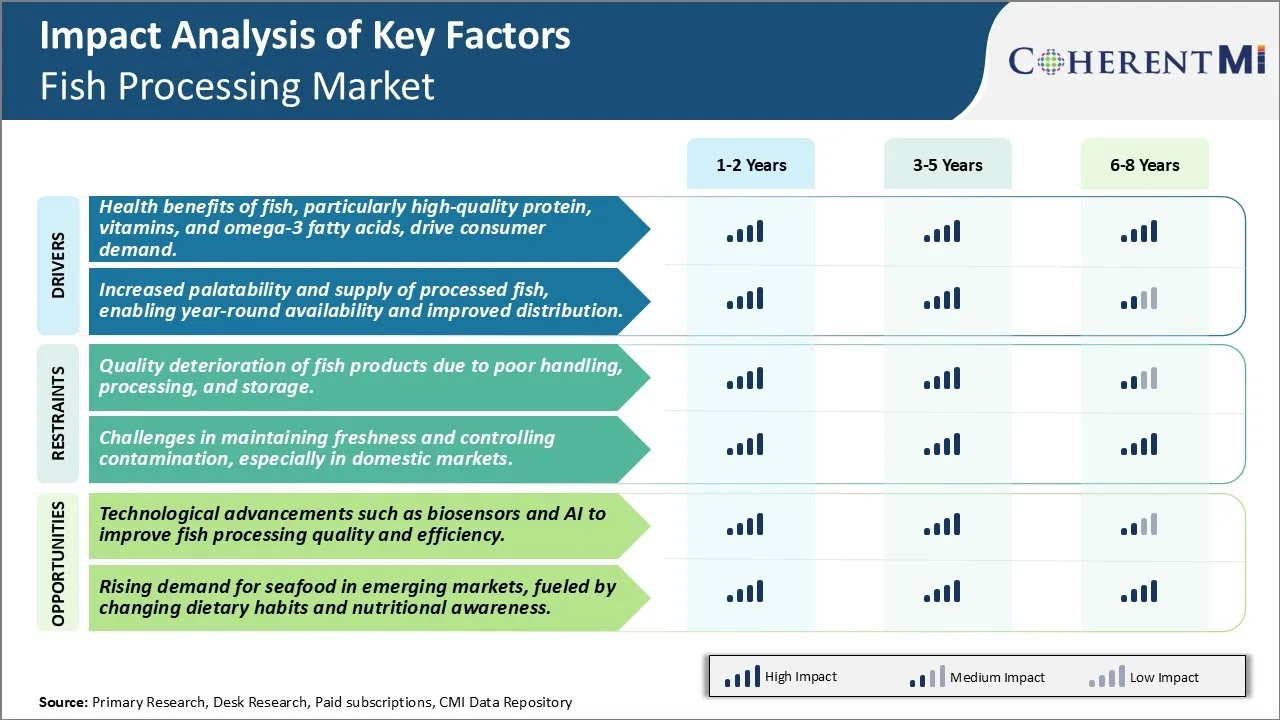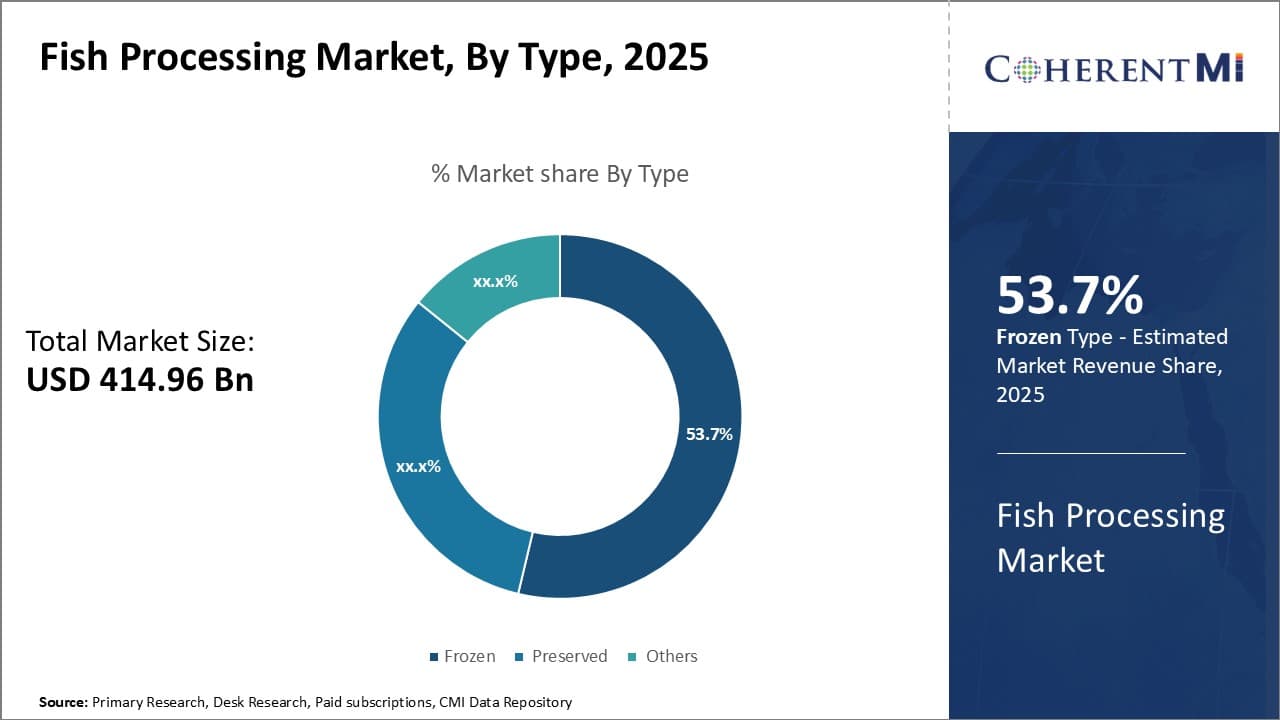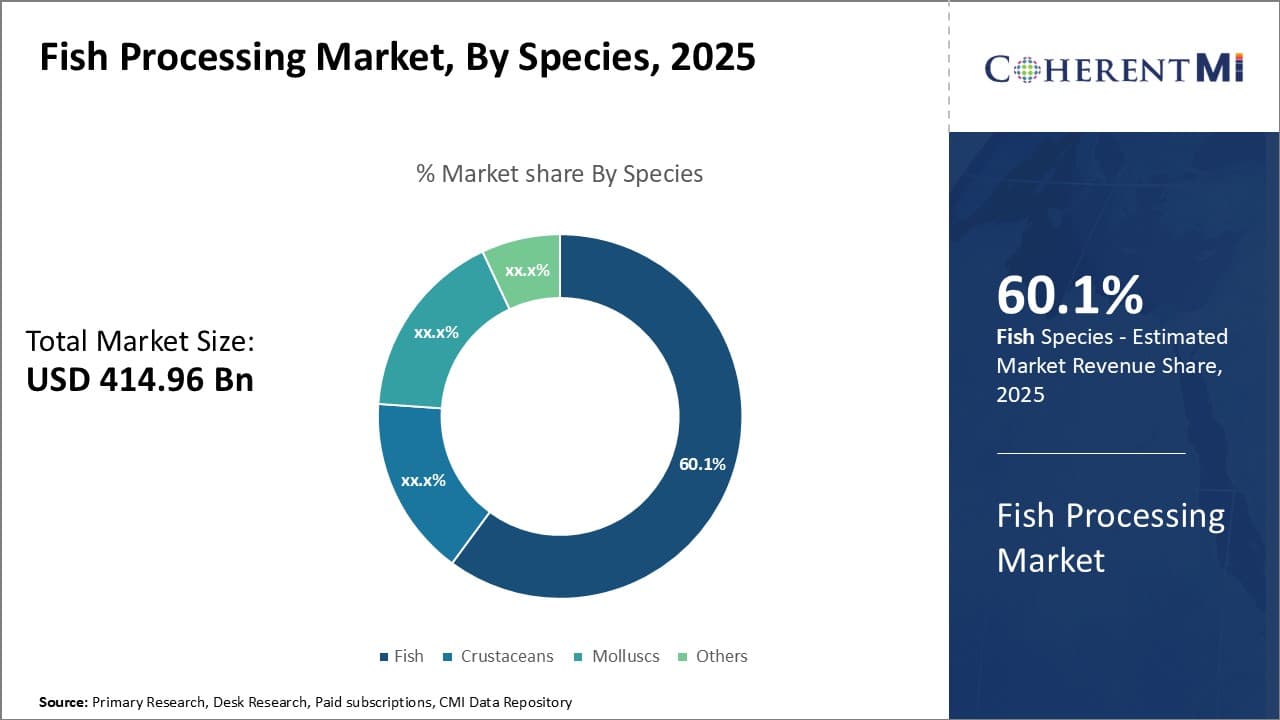

The global fish processing market is estimated to be valued at USD 414.96 Bn in 2025 and is expected to reach USD 690.3 Bn by 2032, growing at a compound annual growth rate (CAGR) of 6.1% from 2025 to 2032. As the demand for seafood rises globally driven by population growth, urbanization and rising incomes, the need to process bulk catches efficiently and safely will drive the expansion of this industry to meet supply.
The market is witnessing rising popularity of ready-to-eat seafood products owing to busier lifestyles and preference for convenience. Furthermore, increasing health consciousness is boosting demand for protein-rich fish and other seafood. Advancements in processing technologies to improve yields, productivity and food safety standards while reducing environmental impact will be crucial for players looking to tap growing opportunities in this space over the coming years.
Market Size in USD Bn
CAGR6.1%
| Study Period | 2025-2032 |
| Base Year of Estimation | 2024 |
| CAGR | 6.1% |
| Market Concentration | Medium |
| Major Players | Alpha Ocean Resources Berhad, Kyokuyo Co., Ltd., Trident Seafoods, American Seafoods Group, LLC, Mowi ASA and Among Others |
Market Driver - Health Benefits of Fish, Particularly High-Quality Protein, Vitamins, and Omega-3 Fatty Acids, Drive Consumer Demand
The abundantly available health benefits of eating fish are major aspects for the growth of fish processing market. Fish is considered as one of the healthiest foods for the human body owing to its high-quality protein content and presence of essential vitamins and nutrients. Compared to other meat varieties, fish is lower in saturated fat and contains higher amounts of anti-inflammatory omega-3 fatty acids like EPA (eicosapentanoic acid) and DHA (docosahexanoic acid). Numerous studies conducted by health organizations and experts have continuously highlighted that regular consumption of fish, at least twice a week, provides significant health advantages.
Some of the widely known health benefits of eating fish include reduced risk of heart disease, improved brain and eye health, stronger bones and joints, better pregnancy outcomes and enhanced cognitive development in infants. The omega-3 fatty acids present in fish are proven to reduce triglyceride levels and chances of irregular heartbeats which may further prevent life threatening conditions like heart attacks and strokes. Diets rich in fish also seem to lower the incidence of depression and slow mental decline related to aging. Fish also stands out as a brain food due to its high-quality protein content that aids in building new neurons and repairing damaged ones. In pregnancy, omega-3s from fish aid in fetal brain development and support a healthy birth weight of babies. With rising awareness about these biological advantages, people are gradually adopting seafood as a healthy meal option leading to higher spending on processed fish products.
Market Driver - Increased Palatability and Supply of Processed Fish Drives the Industry Growth
With growing urbanization and changing lifestyles, consumers are increasingly demanding convenient ready-to-eat food options instead of spending time in cooking meals. Processed fish meets this growing need of instant yet nutritious meal solutions. As compared to whole fish, value-added forms like frozen fish fingers, breaded fish fillets, fish sticks facilitate easier preparation and consumption. The processing methods enhance the flavors and textures making fish more palatable for people who are averse to its smell and taste in fresh form. Effective preservation techniques involve steps like freezing, curing and canning which help extend the shelf-life of fish significantly without compromising its nutritional value. This enables year-long availability of different fish varieties even in regions experiencing seasonal scarcity.
Better transportation and cold chain logistics have augmented the supply chain efficiencies for processed fish industry players. With rising production capacities, companies are now able to supply processed fish products to a wider geographical market on a larger scale meeting both retail and foodservice demands. This has boosted their availability across modern retail formats in urban centers as well as smaller towns within a nation or even globally. While previously certain fish could be directly obtained only from coastlines due to lack of preservation, advanced processing ensures perennial supply through distribution channels. Overall, improved palatability and efficient supply chain management have increased fish intake by addressing the inconvenience of its perishable and seasonal nature. The growth in demand for convenient options drives greater market potential for processed fish products.
 To learn more about this report, Download Free Sample Copy
To learn more about this report, Download Free Sample Copy
Market Challenge - Quality Deterioration of Fish Products Due to Poor Handling, Processing, and Storage
Quality deterioration of fish products due to poor handling, processing, and storage has remained one of the major challenges for the fish processing market. As fish are highly perishable in nature, any delay in handling, processing or improper storage leads to quality loss making the products unfit for consumption. The shortage of modern infrastructure facilities at landing centers and processing plants further exacerbates the situation. Inadequate cold chain facilities from the point of landing/harvest to the processing units and lack of proper temperature-controlled transportation and storage increases the chances of quality deterioration. Besides, the unorganized nature of the supply chain with presence of multiple middlemen also results in delays further resulting in quality loss. Ensuring freshness and longevity throughout the supply chain remains a formidable challenge for the industry. The market is also facing challenges to meet the increasing quality and safety standards set by importing countries and regulators. These challenges have not only impacted the export potential but also led to huge economic losses for the industry players.
Market Opportunity -Technological Advancements to Boost the Industry Developments in the Forecast Period
The fish processing market provides massive opportunities with technological advancements such as biosensors and AI improving quality and efficiency. Biosensors which can detect the freshness of fish by monitoring chemical and biochemical changes have potential to revolutionize quality assurance. These non-destructive testing techniques enable real-time monitoring of fish quality right from harvesting to end consumption. Artificial intelligence and machine learning algorithms are helping players optimize plant operations from grading and sorting to automated processing. Automated quality inspection systems supported by computer vision and AI can accurately evaluate the quality attributes with higher precision reducing human errors. Integration of IoT and blockchain in the supply chain enables traceability of fish products and ensures compliance to quality and safety standards preferred by importers and consumers. Technological innovations are thus paving way for enhanced food safety, improved shelf-life along with efficient resource utilization presenting lucrative scope for growth in the fish processing market.
Focus on value-added products: One of the most successful strategies adopted by leading companies has been shifting their focus from commoditized fish products to value-added items. For example, Marine Harvest, one of the largest salmon farmers globally, has ramped up its production of portion-controlled and packaged salmon cuts, fillets, and smoked salmon products in the late 2000s. This allowed the company to command higher margins. Today, over 50% of Marine Harvest's salmon is sold as value-added products.
Geographic and product expansion: Many top players have grown aggressively through acquisitions that allow geographic and product portfolio expansion.
Establish own farming and harvesting operations: Vertically integrating upstream has helped weaken competitors' control over supply. Companies like Mowi (formerly Marine Harvest) cultivate over 300,000 tons of salmon through their own farms annually. This ensures consistent supply of raw materials and price stability. They have been able to raise salmon at lower costs compared to smaller players who depend on suppliers.
Focus on food safety and sustainability: Emphasis on food safety and sustainability aspects has helped top brands gain consumer confidence.
Advanced cold chain infrastructure: Companies like Iglo Group having temperature-controlled, state-of-the-art processing and distribution infrastructure ensures the highest product quality is delivered to their consumers.
 To learn more about this report, Download Free Sample Copy
Insights, By Type, Frozen is the Leading Segment in the Forecast Period
To learn more about this report, Download Free Sample Copy
Insights, By Type, Frozen is the Leading Segment in the Forecast Period
By type, frozen is expected to contribute 53.7% in 2025 owing to convenience and longer shelf life. The frozen fish processing segment dominates the market owing to the sheer convenience it offers consumers and businesses. Freezing fish quickly after catching or processing them helps preserve their quality and nutritional value for a longer period. The freezing process slows down the growth of microorganisms and prevents the fish from spoiling, allowing frozen fish to retain its original form and taste for several months when stored at appropriate temperatures.
For consumers, frozen fish means flexibility in cooking and enjoying seafood any day of the week without having to buy fresh catch. The busy modern lifestyles leave little time for daily grocery shopping, so frozen varieties provide an easy option. For food service providers and retailers, frozen fish have significantly lower risks of spoilage and wastage compared to fresh offerings. The long shelf life reduces inventory costs and brings more stability in supply chains.
Advances in freezing technologies have further improved the quality of frozen fish. Individually quick freezing (IQF) and cryogenic freezing methods freeze fish at very low temperatures within a short time, preventing formation of large ice crystals that can damage texture. As a result, frozen fish after thawing rivals fresh-caught varieties in appearance and taste. With quality and convenience advantages, the frozen fish processing segment continues to be the major growth driver in the industry.
 To learn more about this report, Download Free Sample Copy
To learn more about this report, Download Free Sample Copy
Insights, By Species, the Fish segment is Poised to Witness a Remarkable Growth in the Forecast Period
By species, fish is expected to contribute 60.1% in 2025 owing to wide availability and myriad culinary usages. Within the fish processing industry segmented by species, fish varieties such as salmon, tuna, cod, pomfret and mackerel collectively account for the largest share. This is attributed to their abundant availability across both marine and aquaculture sources as well as diverse cooking methods.
Fish is one of the most versatile ingredients used in global cuisines. Different fish varieties lend themselves to preparations like grilling, baking, frying, currying or making soups and stews. Their mild taste also allows experimental blending with diverse seasonings from various world food cultures. Salmon, in particular, has emerged as a popular ingredient in fusion global dishes along with sushi and sashimi from Asia. Being a major source of affordable protein, fish is also in high demand from health-conscious consumers. Meanwhile, seafood companies cultivate different fish in commercial fisheries & aquaculture farms to ensure steady supplies. With availability of various cuts and processed forms, fish raw materials provide convenience and value to food manufacturers, retailers and foodservice businesses.
Owing to these culinary and supply-related factors, the fish segment will likely retain its top position compared to other seafood varieties like crustaceans and molluscs in the fish processing industry. Continuous innovation and evolving tastes will further drive the growth of this dominant category.
Health-conscious consumers are increasingly turning to fish for its high-quality protein, vitamins, and omega-3 fatty acids, driving demand for processed fish. Technological advancements such as artificial intelligence (AI) and biosensors are revolutionizing fish processing, making it more efficient and improving quality control. However, challenges remain, including quality deterioration due to improper handling and storage, particularly in domestic markets. Countries in Asia-Pacific, especially China, dominate the market, while North America is expected to grow rapidly due to increasing aquaculture production and strong institutional support. Overall, the market is poised for growth, driven by the rising global demand for seafood, technological innovations, and expanding production capabilities in key regions.
The major players operating in the Fish Processing Market include Alpha Ocean Resources Berhad, Kyokuyo Co., Ltd., Trident Seafoods, American Seafoods Group, LLC, Mowi ASA, Beaver Street Fisheries, Grieg Seafood, Associated Seafoods Ltd., Aurum Freight International Ltd., Bomar Seafood, Costamar, Sea Pride LLC, Oman Fisheries Co. SAOG and The Deep Seafood Company.
Would you like to explore the option of buying individual sections of this report?
Sakshi Suryawanshi is a Research Consultant with 6 years of extensive experience in market research and consulting. She is proficient in market estimation, competitive analysis, and patent analysis. Sakshi excels in identifying market trends and evaluating competitive landscapes to provide actionable insights that drive strategic decision-making. Her expertise helps businesses navigate complex market dynamics and achieve their objectives effectively.
Fish Processing Market is segmented By Type (Frozen, Preserved, Others), By Species (Fish, Crustacea...
Fish Processing Market
How Big is the Fish Processing Market?
The global fish processing market is estimated to be valued at USD 414.96 Bn in 2025 and is expected to reach USD628.08 Bn by 2032.
What will be the CAGR of the Fish Processing Market?
The CAGR of the Fish Processing Market is projected to be 5.9% from 2024 to 2031.
What are the key factors hampering the growth of the Fish Processing Market?
The quality deterioration of fish products due to poor handling, processing, and storage and challenges in maintaining freshness and controlling contamination, especially in domestic markets are the major factors hampering the growth of the Fish Processing Market.
What are the major factors driving the Fish Processing Market growth?
The health benefits of fish, particularly high-quality protein, vitamins, and omega-3 fatty acids, drive consumer demand and increased palatability and supply of processed fish, enabling year-round availability and improved distribution are the major factors driving the Fish Processing Market.
Which is the leading Type in the Fish Processing Market?
Frozen is the leading Type segment.
Which are the major players operating in the Fish Processing Market?
Alpha Ocean Resources Berhad, Kyokuyo Co., Ltd., Trident Seafoods, American Seafoods Group, LLC, Mowi ASA, Beaver Street Fisheries, Grieg Seafood, Associated Seafoods Ltd., Aurum Freight International Ltd., Bomar Seafood, Costamar, Sea Pride LLC, Oman Fisheries Co. SAOG, The Deep Seafood Company are the major players.